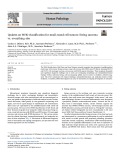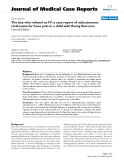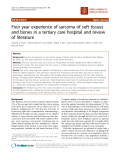
Bone sarcomas
-
The WHO Classification of Soft Tissue and Bone Tumours currently recognizes four categories of undifferentiated small round cell sarcoma: Ewing sarcoma, round cell sarcoma with EWSR1-non-ETS fusions including NFATc2 and PATZ1, CIC-rearranged sarcoma, and sarcoma with BCOR genetic alterations. These neoplasms frequently pose significant diagnostic challenges due to rarity and overlapping morphologic and immunohistochemical findings.
 13p
13p  maitrangytb_94
maitrangytb_94
 24-07-2024
24-07-2024
 11
11
 3
3
 Download
Download
-
Tuyển tập báo cáo các nghiên cứu khoa học quốc tế ngành y học dành cho các bạn tham khảo đề tài: The boy who refused an IV: a case report of subcutaneous clodronate for bone pain in a child with Ewing Sarcoma...
 4p
4p  thulanh27
thulanh27
 14-12-2011
14-12-2011
 35
35
 4
4
 Download
Download
-
Tuyển tập báo cáo các nghiên cứu khoa học quốc tế ngành y học dành cho các bạn tham khảo đề tài: Four year experience of sarcoma of soft tissues and bones in a tertiary care hospital and review of literature
 7p
7p  hoami_238
hoami_238
 11-10-2011
11-10-2011
 45
45
 3
3
 Download
Download
-
Chondrosarcoma Chondrosarcoma, which constitutes ~20–25% of all bone sarcomas, is a tumor of adulthood and old age with a peak incidence in the fourth to sixth decades of life. It has a predilection for the flat bones, especially the shoulder and pelvic girdles, but can also affect the diaphyseal portions of long bones. Chondrosarcomas can arise de novo or as a malignant transformation of an enchondroma or, rarely, of the cartilaginous cap of an osteochondroma. Chondrosarcomas have an indolent natural history and typically present as pain and swelling.
 5p
5p  konheokonmummim
konheokonmummim
 03-12-2010
03-12-2010
 69
69
 4
4
 Download
Download
-
Cancer in the bone may produce osteolysis, osteogenesis, or both. Osteolytic lesions result when the tumor produces substances that can directly elicit bone resorption (vitamin D–like steroids, prostaglandins, or parathyroid hormone–related peptide) or cytokines that can induce the formation of osteoclasts (interleukin 1 and tumor necrosis factor). Osteoblastic lesions result when the tumor produces cytokines that activate osteoblasts. In general, purely osteolytic lesions are best detected by plain radiography, but they may not be apparent until they are 1 cm.
 5p
5p  konheokonmummim
konheokonmummim
 03-12-2010
03-12-2010
 102
102
 4
4
 Download
Download
-
Stage Grouping Stage IA T1 N0 M0 G1,2 low grade Stage IB T2 N0 M0 G1,2 low grade Stage IIA T1 N0 M0 grade G3,4 high Stage IIB T2 N0 M0 G3,4 high grade Stage III T3 N0 M0 Any G Stage IVA T Any N0 M1a Any G Stage IVB T Any N1 M Any Any G Any T N Any M1b Any G Osteosarcoma Osteosarcoma, accounting for almost 45% of all bone sarcomas, is a spindle cell neoplasm that produces osteoid (unmineralized bone) or bone.
 4p
4p  konheokonmummim
konheokonmummim
 03-12-2010
03-12-2010
 86
86
 4
4
 Download
Download
-
Bone Sarcomas Incidence and Epidemiology Bone sarcomas are rarer than soft tissue sarcomas; they accounted for only 0.2% of all new malignancies and 2370 new cases in the United States in 2007. Several benign bone lesions have the potential for malignant transformation. Enchondromas and osteochondromas can transform into chondrosarcoma; fibrous dysplasia, bone infarcts, and Paget's disease of bone can transform into either malignant fibrous histiocytoma or osteosarcoma.
 5p
5p  konheokonmummim
konheokonmummim
 03-12-2010
03-12-2010
 93
93
 4
4
 Download
Download
-
Disease Stage 5-Year Survival, % Stage I 98.8 A: G1,2; T1a,b; N0; M0 B: G1,2; T2a; N0; M0 Stage II 81.8 A: G1,2; T2b; N0; M0 B: G3,4; T1; N0; M0 C: G3,4; T2a; N0; M0 Stage III G3,4; T2b; N0; M0 51.7 Stage IV
 5p
5p  konheokonmummim
konheokonmummim
 03-12-2010
03-12-2010
 129
129
 4
4
 Download
Download
-
Tham khảo tài liệu 'chapter 094. soft tissue and bone sarcomas and bone metastases (part 2)', y tế - sức khoẻ, y học thường thức phục vụ nhu cầu học tập, nghiên cứu và làm việc hiệu quả
 5p
5p  konheokonmummim
konheokonmummim
 03-12-2010
03-12-2010
 100
100
 3
3
 Download
Download
-
Classification Approximately 20 different groups of sarcomas are recognized on the basis of the pattern of differentiation toward normal tissue. For example, rhabdomyosarcoma shows evidence of skeletal muscle fibers with cross-striations; leiomyosarcomas contain interlacing fascicles of spindle cells resembling smooth muscle; and liposarcomas contain adipocytes. When precise characterization of the group is not possible, the tumors are called unclassified sarcomas. All of the primary bone sarcomas can also arise from soft tissues (e.g., extraskeletal osteosarcoma).
 5p
5p  konheokonmummim
konheokonmummim
 03-12-2010
03-12-2010
 99
99
 7
7
 Download
Download
CHỦ ĐỀ BẠN MUỐN TÌM






















